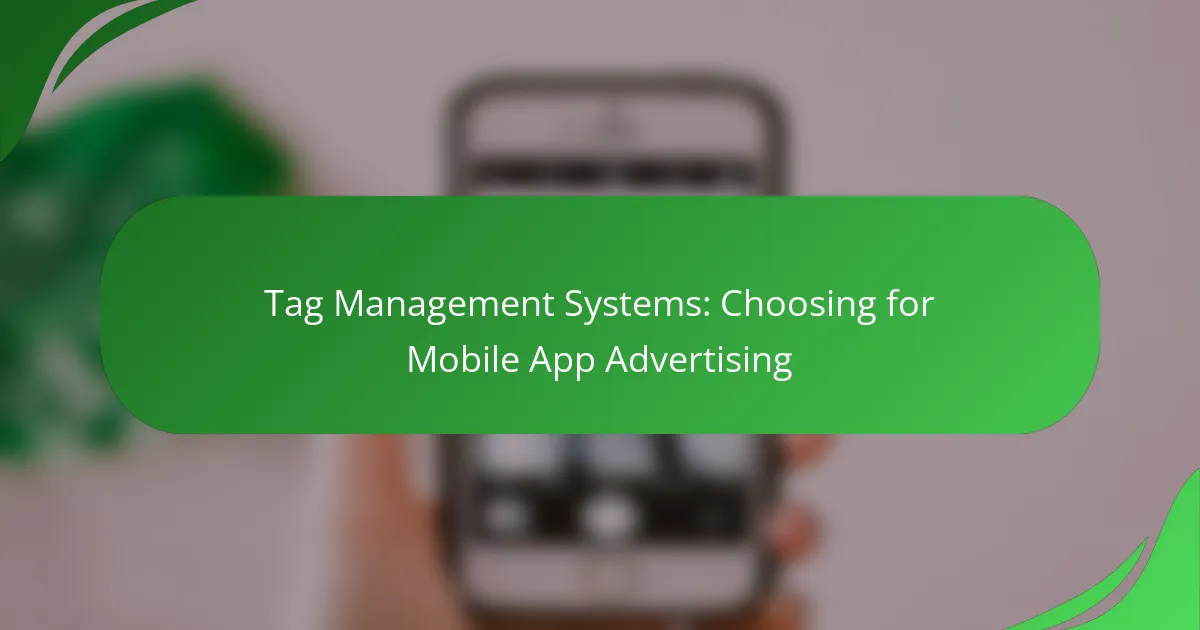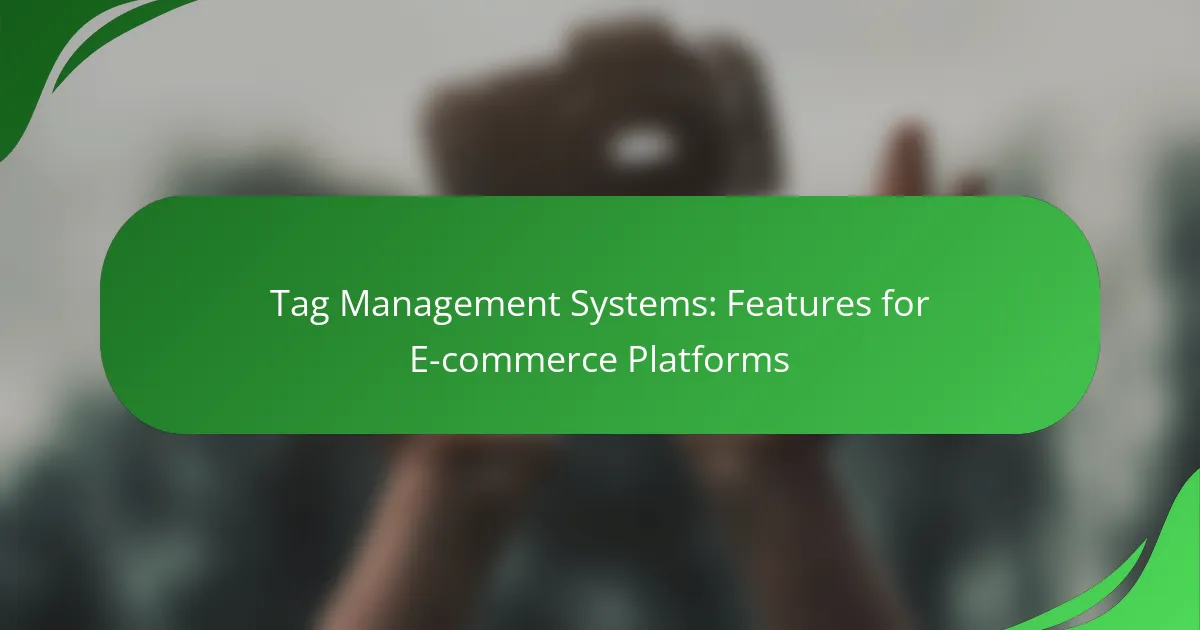Choosing the right tag management system (TMS) for mobile app advertising is crucial for optimizing marketing efforts and enhancing user engagement. Effective TMS solutions streamline the integration and management of tracking tags, enabling marketers to deploy updates efficiently without extensive coding. When evaluating options, consider usability, integration capabilities, and mobile support to ensure a seamless advertising experience.

What are the best tag management systems for mobile app advertising in Canada?
The best tag management systems for mobile app advertising in Canada include Google Tag Manager, Tealium, Adobe Experience Platform Launch, Segment, and Adjust. These platforms help streamline the implementation of marketing tags, allowing for efficient data collection and analysis tailored to the Canadian market.
Google Tag Manager
Google Tag Manager (GTM) is a widely used tag management system that simplifies the process of adding and updating tags for mobile apps. It allows marketers to manage tags without needing extensive coding knowledge, making it accessible for teams of all sizes.
With GTM, you can deploy various tags for analytics, advertising, and conversion tracking. It supports integration with Google Analytics and other third-party tools, which is crucial for optimizing mobile app advertising strategies in Canada.
Tealium
Tealium offers a robust tag management solution that focuses on data governance and real-time data collection. Its features include a comprehensive library of pre-built integrations with major advertising platforms, which can enhance your app’s advertising capabilities.
Tealium’s AudienceStream feature allows for advanced audience segmentation, enabling targeted advertising campaigns. This is particularly beneficial for Canadian marketers looking to tailor their messaging to specific demographics.
Adobe Experience Platform Launch
Adobe Experience Platform Launch provides a flexible and scalable tag management solution that integrates seamlessly with Adobe’s suite of marketing tools. It allows users to manage tags efficiently while leveraging Adobe’s powerful analytics capabilities.
This platform is ideal for businesses already using Adobe products, as it enhances data-driven decision-making. Canadian marketers can benefit from its ability to customize tags based on user behavior and preferences.
Segment
Segment is a customer data platform that simplifies data collection and management across various channels, including mobile apps. It allows businesses to send data to multiple marketing tools without needing to implement each tag individually.
For Canadian advertisers, Segment’s ability to unify data from different sources can lead to more effective advertising strategies. It supports compliance with local regulations, ensuring that data handling meets Canadian privacy standards.
Adjust
Adjust specializes in mobile measurement and fraud prevention, making it a valuable tag management system for mobile app advertising. It provides insights into user acquisition and engagement, helping marketers optimize their campaigns.
With features like real-time analytics and cohort tracking, Adjust enables Canadian businesses to understand their app’s performance better. Its focus on mobile-specific metrics makes it a strong choice for advertisers looking to maximize their return on investment.

How do tag management systems improve mobile app advertising?
Tag management systems (TMS) enhance mobile app advertising by simplifying the integration and management of tracking tags. They allow marketers to deploy and update tags without needing extensive coding, leading to more efficient advertising strategies and improved user targeting.
Streamlined tracking
Streamlined tracking is a key benefit of tag management systems, as they consolidate multiple tracking codes into a single interface. This reduces the complexity of managing various tags and minimizes the risk of errors that can occur with manual implementations.
For example, a TMS can automatically update tracking codes across all platforms, ensuring that data collection remains consistent and accurate. This efficiency allows marketers to focus more on strategy rather than technical details.
Enhanced data collection
Enhanced data collection through a TMS allows for more comprehensive insights into user behavior. By integrating various analytics tools, marketers can gather data from different sources, such as in-app purchases, user engagement, and ad performance.
With better data collection, businesses can segment their audience more effectively, tailoring advertising efforts to specific user groups. This targeted approach can lead to higher conversion rates and improved return on investment (ROI).
Real-time updates
Real-time updates are a significant advantage of using a tag management system, enabling marketers to make immediate changes to their tracking setup. This flexibility is crucial for adapting to new advertising strategies or responding to market changes quickly.
For instance, if a new advertising campaign is launched, a TMS allows for instant deployment of necessary tags without waiting for development cycles. This agility helps maintain the effectiveness of advertising efforts and ensures that data remains relevant and actionable.

What features should I look for in a tag management system?
When selecting a tag management system (TMS) for mobile app advertising, prioritize features that enhance usability, integration, and mobile support. A robust TMS should streamline the management of tags, facilitate seamless integration with other tools, and ensure compatibility with mobile platforms.
User-friendly interface
A user-friendly interface is crucial for efficient tag management. Look for systems that offer intuitive navigation, drag-and-drop functionality, and clear labeling of features. This will reduce the learning curve and allow your team to implement tags quickly and effectively.
Consider systems that provide visual previews of tags and their placements within the app. This feature can help you understand how tags will function in real-time, making it easier to troubleshoot any issues that arise.
Integration capabilities
Integration capabilities are essential for a tag management system to work effectively with your existing marketing tools. Ensure that the TMS can connect with analytics platforms, advertising networks, and customer relationship management (CRM) systems. This will enable you to gather data from various sources and optimize your advertising strategies.
Check for pre-built integrations with popular services like Google Analytics, Facebook Ads, and other marketing automation tools. A TMS that supports these integrations can save you time and reduce the complexity of managing multiple platforms.
Support for mobile platforms
Support for mobile platforms is vital for any tag management system focused on mobile app advertising. Ensure the TMS can handle mobile-specific tags and SDKs, which are necessary for tracking user behavior and app performance. This capability will enhance your ability to gather insights and improve user engagement.
Look for features that allow for easy deployment of tags across both iOS and Android platforms. A TMS that simplifies this process can help you maintain consistency in tracking and reporting across different mobile environments.

How do I choose the right tag management system for my mobile app?
Choosing the right tag management system (TMS) for your mobile app involves assessing your specific business needs, evaluating pricing models, and considering scalability. A suitable TMS can streamline your advertising efforts, improve data collection, and enhance user experience.
Assess business needs
Start by identifying the primary objectives of your mobile app and how a tag management system can support them. Consider factors such as the types of data you need to collect, the analytics tools you plan to integrate, and the specific advertising goals you aim to achieve.
For example, if your app focuses on e-commerce, you may require robust tracking for user behavior and conversion rates. Conversely, a content-driven app might prioritize engagement metrics and user retention data.
Evaluate pricing models
Tag management systems typically offer various pricing structures, including subscription-based models, pay-per-use, or tiered pricing based on features. Assess which model aligns best with your budget and anticipated usage.
Some TMS providers may charge a flat monthly fee, while others might base costs on the volume of tags or data processed. It’s essential to project your app’s growth to avoid unexpected expenses as your needs evolve.
Consider scalability
Scalability is crucial when selecting a tag management system, especially for mobile apps that may experience fluctuating user traffic. Ensure that the TMS can handle increased data loads and additional tags without compromising performance.
Look for systems that offer flexible features, such as the ability to add new tags easily or integrate with additional analytics tools as your app grows. This adaptability will help you maintain efficiency and effectiveness in your advertising strategies over time.

What are the common challenges with tag management systems?
Tag management systems (TMS) can streamline mobile app advertising, but they often present several challenges. Key issues include implementation complexity, performance impacts, and maintaining data accuracy.
Implementation complexity
Implementation complexity refers to the technical difficulties involved in setting up a tag management system. This can include integrating with existing app infrastructure, ensuring compatibility with various platforms, and configuring tags correctly to avoid errors.
To mitigate these challenges, consider using a TMS that offers robust documentation and support. Additionally, involving your development team early in the process can help identify potential issues before they arise.
Common pitfalls include underestimating the time required for setup and failing to test tags thoroughly before going live. A checklist of essential steps can help streamline the implementation process:
- Assess current tagging needs and objectives.
- Choose a TMS that aligns with your technical capabilities.
- Conduct thorough testing across multiple devices.


